Abstract
It is well established that exposure to heat-stress conditions significantly impacts the physiology, health, welfare, and productivity of both sheep and cattle. The aim of this study was to apply the Temperature Humidity Index (THI) in order to assess the impact of future climate conditions on the thermal stress exposure of sheep and cattle in Greece. The Weather Research and Forecasting (WRF) model was used as a high-resolution regional climate model to simulate climate conditions for two decades in Greece at a 10 Km spatial resolution and a 1 h temporal resolution. The WRF model was applied to two emission scenarios, namely SSP2-4.5 (intermediate) and SSP5-8.5 (worst-case). Projections were made for the near-future decade (2046–2055), with the decade (2005–2014) serving as the reference period for comparative analysis. The data analysis indicated that under the SSP2-4.5 emission scenario, the mean temperature is projected to increase by 1.2–1.4 °C and 1.4–1.6 °C across 38% and 58% of the country’s territory, respectively. Increases higher than 1.6 °C are projected across 32% of the Greek territory under the SSP5-8.5 emission scenario. The mean THI (sheep) and mean THI (adj) (cattle) are projected to increase by 5–10% and by 4% across 74% and 82% of the Greek territory, respectively, when considering the SSP2-4.5 emission scenario. Slightly more severe mean heat-stress conditions were projected when considering the SSP5-8.5 emission scenario. The analysis of the hourly THI values showed that sheep and cattle are expected to experience heat-stress conditions during extended periods in the future, in which hot weather will prevail. Specifically, the number of severe/danger heat-stress hours is projected to double in the greater part of the country. To mitigate the adverse effects of climate-change-induced thermal stress on animal productivity, health, and welfare, the implementation of adaptation measures and best management practices is strongly recommended for sheep and cattle farmers. These measures encompass improvements in breeding strategies, livestock housing and microclimate management, nutritional interventions, and the adoption of precision livestock farming technologies. Given the outstanding economic, social, and environmental importance of sheep and cattle farming in Greece, effective adaptation to and mitigation of climate change impacts represent urgent priorities to ensure the long-term sustainability and resilience of the livestock sector.
1. Introduction
The livestock sector is a key pillar of the Greek economy, producing food of high nutritional and biological value, thus contributing significantly to the country’s national product. Livestock production is of particular economic, social, and environmental value, as it is a multifunctional activity that utilises mountainous and disadvantaged areas of the country, which are unsuitable for other uses. The significance of livestock production in the national agricultural economy and the country’s development is evidenced by its contribution of 29.7% to the total gross value of agricultural production. Those employed across the value chain in the production and processing of the sector’s products (farmers, feed industries, milk processing plants, slaughterhouses, logistics, suppliers, etc.) amount to several tens of thousands. The contribution of livestock farming to the national economy varies across the branches of animal production, reflecting the distinct roles and market dynamics of each sub-sector. Sheep and goat farming is the most important branch of animal production in Greece. At the European level, Greece ranks first in the number of goats, fourth in sheep population, and first in the production of goat and sheep milk, accounting for approximately 24% of the total output within the European Union []. The economic significance of sheep and goat farming is further indicated by the substantial production of dairy products, with a strong export performance on a global scale (feta cheese, yogurt). In addition, sheep farming is the only branch of the country’s livestock sector exhibiting a positive growth rate. Cattle farming (dairy and meat farms), despite the relatively higher level of know-how it possesses, has lower competitiveness, while the national self-sufficiency rate of the products produced is also low.
Climate conditions affect animal health and welfare. A poor thermal environment can affect the incidence and severity of certain diseases, as well as the animals’ thermal comfort, growth rate, and overall performance, inducing a significant financial burden on livestock producers []. The effects of heat-stress on animal productivity, immunity, and hormonal levels were discussed in detail by []. This study underlined that under heat-stress, a number of physiological and behavioural responses vary in intensity and duration, in relation to the animal’s genetic make-up and environmental factors. Similarly, ref. [] concluded that high temperatures induce adverse effects on the thermoregulation capacity, feed efficiency and metabolism, immune response, reproductive efficiency, udder health, and milk yield of lactating ewes during summer under a Mediterranean climate. In addition, ref. [] found that the milk yield of Mediterranean dairy sheep is affected by heat-stress conditions, whereas [] clearly demonstrated that exposure of sheep to high ambient temperatures has a detrimental impact on their production performance, including the intrinsic quality and technological properties of milk. Under abnormally hot summer conditions, dairy ewes had respiration rates above normal, altering their shade-seeking behaviour []. On the east coast of central Greece, dairy ewes were exposed to potential heat-stress in 79% of summer hours []. On the contrary, a reduction in thermal stress in dairy sheep results in extended lactation periods; an increased cheese yield capacity of the milk; improved animal health and welfare status; and reduced veterinary costs []. The relationships between small ruminant farming and climate change have been described by [], pointing out the effects of heat-stress on animal health, and by [], discussing the overall impacts of climate change on sheep production, reproduction, immune response, diseases, etc.
Considering the aforementioned information, it can be concluded that sheep and cattle farming is crucial for food sufficiency and security and affect important sectors of the Greek agricultural economy, as well as agricultural income. Therefore, a better understanding and efficient management of climate change challenges are crucial for ensuring sustainable and resilient sheep and cattle farming in Greece. The present study was designed to address this critical challenge. Future climate projections were generated and utilised to quantitatively assess changes in heat-stress conditions for sheep and cattle across Greece. Regions that may become more or less favourable for sheep and cattle farming were identified. Evidence-based adaptation measures and best practices were proposed to effectively manage the anticipated increase in animal heat-stress under future climate change scenarios. This study’s strength lies in the integration of climate modelling with animal physiology, providing projections with direct implications for animal production, welfare, and policy-making. To represent future climate conditions, two recently defined Shared Socioeconomic Pathway (SSP) scenarios were employed: SSP2-4.5, a “middle-of-the-road” scenario with moderate mitigation efforts, and SSP5-8.5, a high-emission, fossil-fuel-driven scenario. These scenarios encompass a broad range of plausible socioeconomic and emission trajectories, allowing for a comprehensive assessment of the potential future climate outcomes for Greece. This study highlights the vulnerability of Mediterranean systems and the need for adaptation measures, structured into various interventions. The study offers a high-resolution, scenario-based assessment of climate-change-induced thermal stress tailored to Greece’s livestock sector, thus providing a robust scientific basis for policy and farm-level interventions in a climate-vulnerable sector.
2. Materials and Methods
2.1. Climatic Characterisation of the Study Area []
The climate of Greece is typically Mediterranean: mild and wet winters, relatively hot and dry summers, and, in general, long periods of sunshine during most of the year. Various Greek regions are characterised by a wide variety of climate types within the context of the Mediterranean climate, as their topographic configuration generally differs. The coldest months are January and February, when the mean minimum temperature varies from 5 to 10 °C in coastal areas, from 0 to 5 °C in inland areas, and within lower values below zero in northern areas. The hottest periods are the last ten days of July and the first days of August, when the mean maximum temperature ranges from 29 to 35 °C. During the warm period of the year, coastal temperatures levels are affected by sea breeze circulations and by the Etesians winds.
2.2. Production of Future Climate Projections
The Weather Research and Forecasting (WRF) model [] was used as a high-resolution regional climate model to simulate climate conditions tailored to the specific geographic and climatic features of Greece. Regional climate models are widely used to downscale global climate model outputs, allowing for a more detailed representation of local atmospheric processes such as topographic and coastal effects and land–atmosphere interactions []. Their application is essential in impact assessments such as this study, where fine-scale spatial and temporal features are critical for evaluating sector-specific climate risks, particularly in a country with complex terrain, coastlines, and land use diversity such as Greece. The WRF model has been applied and validated in several studies (namely [,,,]), while past studies have utilised it to investigate the impacts of meteorological and climatological conditions on agricultural systems [,,]. The model simulated climatic conditions across the entirety of Greece for two decades at a spatial resolution of 10 Km and a temporal resolution of 1 h. The projections referred to the near-future decade (2046–2055), while the decade 2005–2014 was used as the reference period for comparative purposes. This decade was used as the reference period because the historical global model simulations from Coupled Model Intercomparison Project Phase 6 (CMIP6), which were used as the boundary conditions for the regional model runs, extend only up to 2014. The simulation of the future decade was based on the Shared Socioeconomic Pathway (SSP) emissions scenario framework, as adopted in the sixth Intergovernmental Panel on Climate Change (IPCC) Assessment Report [,]. The WRF model was applied for two emission scenarios, namely SSP2-4.5 (intermediate scenario) and SSP5-8.5 (worst-case scenario). The intermediate emission scenario is associated with moderate warming and a moderate increase in heatwaves; livestock stress will rise but is likely to be manageable with efficient planning. The worst-case emission scenario is associated with severe warming and frequent and intense heatwaves; livestock stress will remarkably rise, especially in southern and lowland regions.
2.2.1. Model Set Up
Two nested domains, coarse (d01), with a horizontal resolution of 50 km, and fine (d02), with a horizontal resolution of 10 km, were set (Figure 1). D02 focuses on the broader area of Greece in order to better capture the fine-scale climate features and the complex topography of the region. The 10 km grid used in this study represents an optimal compromise between sufficient physical and spatial representation and feasible computational demands. Both domains have the same vertical extent and resolution, ranging from the surface up to 100 hPa and represented through 35 unevenly spaced vertical levels.
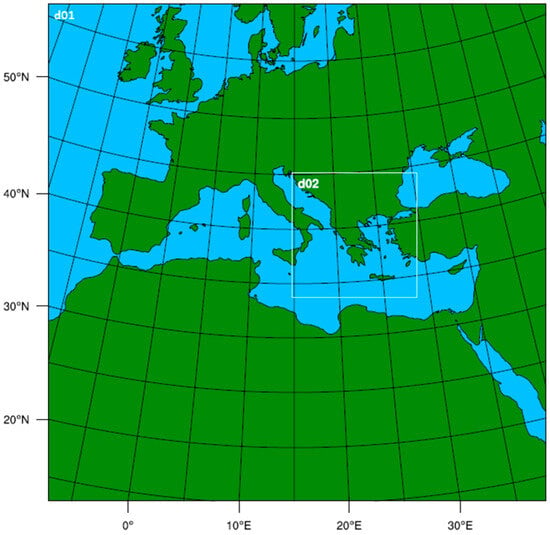
Figure 1.
Configuration of model’s simulation domains.
The following physics schemes were selected for the simulations: WRF Single-Moment 6-class (WSM6) (Microphysics) [], Kain–Fritsch (Cumulus) [], Yonsei University (YSU) (Planetary Boundary Layer) [], revised fifth-generation Pennsylvania State University–National Center for Atmospheric Research Mesoscale Model (MM5) (Surface Layer) [], Noah (Land Surface) [], and Rapid Radiative Transfer Model for Global Climate Models (RRTMG) (Short- and Long-Wave Radiation) []. These choices were based on sensitivity tests and previous studies, which demonstrated their effective representation for the simulation area of interest (e.g., [,]). For land use representation, the Global Land Cover by National Mapping Organizations (GLCNMO v1) dataset [] was utilised.
Dynamical downscaling simulations are often affected by biases in the large-scale forcing data, which can compromise their accuracy. A bias-corrected global dataset, developed by [] specifically for use in dynamical downscaling, was selected as the boundary condition inputs of the simulations; its application offers significantly improved quality, accurately capturing climatological means, interannual variability, and extreme events, while demonstrating an improvement in regional climate simulations when used as the boundary condition input [].
2.2.2. Evaluation of Model’s Performance
To evaluate the model’s performance in reproducing the current climate, the mean monthly values of temperature and relative humidity were evaluated against the corresponding monthly values from the fifth generation European Centre for Medium-Range Weather Forecasts (ECMWF) Reanalysis (ERA5) Land dataset [] for the reference period 2005–2014. Three popular statistical indices were employed to evaluate the model’s performance. The Mean Bias (MB) (Equation (1)) and the Mean Absolute Error (MAE) (Equation (2)) were used to examine the model’s ability to simulate mean climatic values, while Pearson’s coefficient (R) (Equation (3)) was used to examine the model’s performance in simulating climate variability.
In Equations (1)–(3), Mi and Oi represent the mean monthly WRF and ERA5-Land temperature (°C) or relative humidity (%) values, respectively.
2.3. Assessment of Livestock Heat-Stress
In this study, heat-stress in sheep and cattle was assessed using the Temperature Humidity Index (THI), a widely recognised and extensively applied metric in livestock climatology (indicatively: [,,]).
To assess heat-stress in sheep, a specific formulation of the THI as proposed by [] was used (Equation (4)), while the corresponding heat-stress categories are presented in Table 1. Notably, the validity of this definition has been tested under Greek summer conditions; the Chios and Karagouniko breeds of sheep, both well adapted to Greece’s hot and dry climate, exhibited elevated respiration rates, which were significantly related to the THI values calculated using this formulation [].
In Equation (4), T is the dry-bulb temperature (°C), and RH is the relative humidity (%), at a 2 m height.

Table 1.
Sheep heat-stress categories according to the THI values.
Table 1.
Sheep heat-stress categories according to the THI values.
| THI (Sheep) Class | Heat-Stress Category |
|---|---|
| THI (sheep) < 22.2 | absence of heat-stress |
| 22.2 ≤ THI (sheep) < 23.3 | moderate heat-stress |
| 23.3 ≤ THI (sheep) < 25.6 | severe heat-stress |
| THI (sheep) ≥ 25.6 | extremely severe heat-stress |
A formula for the THI adjusted for wind speed and solar radiation proposed by [] was used in this study to assess cattle heat-stress. The THI was calculated using Equation (5), while its adjusted value was calculated using Equation (6). The related heat-stress levels are presented in Table 2. This classification applies to both dairy (Holstein Friesian) and feedlot meat breeds (particularly to breeds such as Angus or Angus-cross cattle), which are commonly used globally in dairy and beef production systems, respectively.
In Equations (5) and (6), T is the dry-bulb temperature (°C) at a 2 m height, RH is the relative humidity (%) at a 2 m height, WS is the wind speed (m·s−1) at a 2 m height, and SR is the incoming solar radiation (W·m−2) at the ground.

Table 2.
Cattle heat-stress categories according to the THI (adj) values.
Table 2.
Cattle heat-stress categories according to the THI (adj) values.
| THI (adj) (Cattle) Class | Heat-Stress Levels |
|---|---|
| THI (adj) (cattle) < 74 | normal heat-stress levels |
| 74 ≤ THI (adj) (cattle) < 79 | alert heat-stress levels |
| 79 ≤ THI (adj) (cattle) < 84 | danger heat-stress levels |
| THI (adj) (cattle) ≥ 84 | emergency heat-stress levels |
2.4. Research Steps
The steps of the research that were followed, from data acquisition to final analysis, included (a) data acquisition (GLCNMO land use from [], bias-corrected CMIP6 boundary condition dataset from []), (b) model performance optimisation based on trial runs and past studies [,], (c) application of the model to the reference and the near-future period, (d) model evaluation, (e) calculation of the THI, and (f) statistical analysis of the hourly THI values and the production of maps and figures.
3. Results
3.1. WRF Model Evaluation and Future Climate Projections
This section analyses the evaluation of the model performance in accurately reproducing the current climate regime (the decade 2005–2014) with respect to temperature and relative humidity. It also presents the near-future (the decade 2046–2055) changes imposed by climate change under the SSP2-4.5 and SSP5-8.5 emission scenarios.
The application of the WRF model generated datasets for each model cell providing the meteorological parameters required in Equations (4)–(6) (T, RH, WS, SR) for both the near future and the reference decade under the two examined emission scenarios. For each model grid cell, the mean T and RH values were calculated for both time periods and emission scenarios; the subsequent analysis presented in this section is based on these T and RH datasets.
3.1.1. WRF Model Evaluation
The values of the statistical indices presented in Section 2.2.2 that were calculated in order to evaluate model’s performance reveal that the model simulates T satisfactorily during the reference period. The mean T across all model grid cells ranges from 5.5 °C to 19.7 °C, accurately capturing the spatial T range, variability, and distribution in Greece. The MB values range between −2.8 °C and 1.9 °C, with a mean value of −0.5 °C, indicating an overall underestimation of T by the model. However, this overestimation is largely confined to mountainous areas and particularly the Pindos mountain range, while the vast majority of the country (>78% of grid cells) presents values between −1 °C and 1 °C. Indicatively, MB values lower than −2 °C are found almost exclusively in the Pindos mountains, accounting for less than 1.5% of the total grid cells. MAE values range between 0.8 °C and 3.0 °C, with a mean value of 1.7 °C. As with MB, higher MAE values are concentrated in the Pindos mountains, whereas 85% of the grid cells show MAE values below 2 °C. The R values exceed 0.95 in all of Greece, with the eastern part of the country presenting values up to 0.99. These results indicate that the model performs well in simulating the present-day T, with the exception of the complex and steep topography area of the Pindos mountain range, where larger discrepancies are observed.
The values of the statistical indices presented in Section 2.2.2 that were calculated in order to evaluate the model’s performance reveal that the model adequately represents the current climate of Greece with regards to RH. However, larger discrepancies are found compared to those for T, as RH is a more complex parameter, strongly influenced by T, moisture transport, and precipitation. The simulated mean annual RH for the reference period ranges between 54.5% and 79.6%. MB values span from −16.5% to 13.9%, with a domain-wide mean of −2.0%. Positive RH biases are concentrated in mountainous regions, particularly the Pindos range, likely due to the concurrent underestimation of T in the region, leading to a reduced air capacity for moisture. The majority of the country (>68% of total grid cells) present values between −6% and 6%. The MAE presents values between 3.5% and 16.7%, with a mean value of 7.9%. Most of the country (>86% of grid cells) presents MAE values lower than 10%, with the highest errors occurring in mountainous areas and along steep coastal regions. The R values are higher than 0.6 in most of the country, with a west-to-east gradient as in the case of T, reaching values higher than 0.8 in the eastern continental parts of Greece. However, the model performs poorly over the Ionian and certain Aegean islands, where the R values can fall below zero. This is a clear indication that the 10 km spatial resolution of the model is not enough to adequately resolve these small islands. In total, the model presents satisfactory skill in reproducing the current climatology of RH for most of its mainland regions and large islands. A lower to poor performance is demonstrated in areas with complex and steep topography, steep coastlines, and small islands, features that remain unresolved at the model’s spatial resolution.
3.1.2. WRF Model Future Climate Projections
The mean ΔΤ projections are presented in Figure 2. For the intermediate emission scenario (SSP2-4.5), the mean T is projected to increase by 1.2–1.4 °C in the area that covers Western Greece, Crete, and the Ionian and Aegean islands, while a higher increase, namely 1.4–1.6 °C, is projected for almost the rest of the country (Figure 2a). These regions correspond to 38% and 58%, respectively, of the country’s territory (Figure 3). For the worst-case emission scenario (SSP5-8.5), a clear shift to higher ΔΤ classes is projected (Figure 3). Mean T increases higher than 1.6 °C are projected for central Greece (Figure 2b), corresponding to an area that accounts for 32% of Greek territory (Figure 3). Increases by 1.4–1.6 °C are projected for almost the rest of the country (Figure 2b), corresponding to 61% of Greek territory (Figure 3).
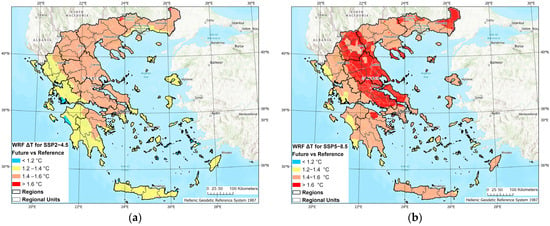
Figure 2.
The projected difference (future vs. reference period) in mean temperature (ΔΤ) (°C) at 2 m for each model grid cell under the SSP2-4.5 (a) and SSP5-8.5 (b) emission scenarios across Greece.
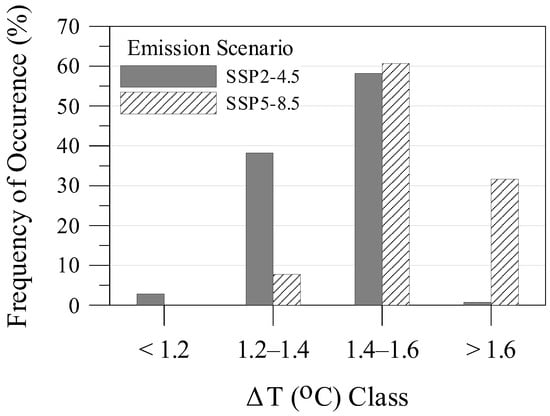
Figure 3.
Frequency of occurrence (%) of the number of model grid cells exhibiting each mean temperature difference (ΔΤ) (°C) class presented in Figure 2.
The mean ΔRH projections are presented in Figure 4. For the intermediate emission scenario (SSP2-4.5), the mean RH is projected to decrease by up to −1% in the area that covers Western Greece, the greater part of Thrace, and the Northern Aegean islands; more than −2% in the area that covers Western Macedonia and the mountainous areas of central Greece; and by −1% to −2% in the rest of the country (Figure 4a). These regions correspond to 27%, 16%, and 57%, respectively, of the country’s territory (Figure 5). For the worst-case emission scenario (SSP5-8.5), a clear shift to lower ΔRH classes is projected (Figure 5). The mean RH is projected to decrease by up to −1% and by −1% to −2% in areas that correspond to 63% and 33%, respectively, of the country’s territory, while the mean RH is projected to mildly increase in small parts of the west (Figure 4b and Figure 5). This result is somewhat counter-intuitive, as the stronger warming under SSP5-8.5 would, in principle, suggest a greater decrease in relative humidity, given that warmer air can hold more moisture, even if the absolute atmospheric water content remains constant. However, this thermodynamic effect may be offset by increased evaporation over the Mediterranean due to elevated temperatures []. In addition, changes in regional circulation patterns could influence future RH values by affecting moisture transport [], as well as orographic convection and precipitation, in the west and the Pindos mountain range, where the differences between the two scenarios are most pronounced. Hence, these findings reflect the complex interaction between thermodynamic and dynamic processes in determining future relative humidity patterns.
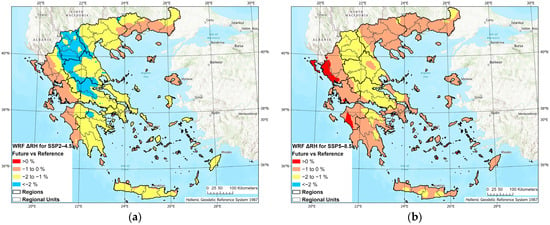
Figure 4.
The projected difference (future vs. reference period) in the mean relative humidity (ΔRH) (%) at 2 m for each model grid cell under the SSP2-4.5 (a) and SSP5-8.5 (b) emission scenarios across Greece.
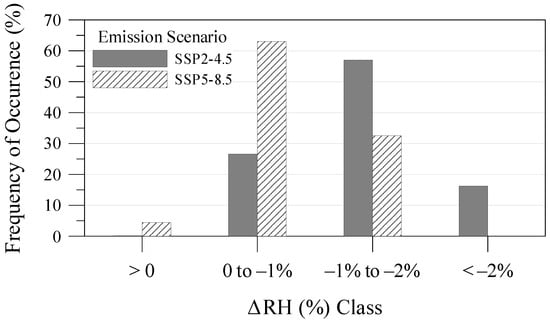
Figure 5.
Frequency of occurrence (%) of the number of model grid cells exhibiting each mean relative humidity difference (ΔRH) (%) class presented in Figure 4.
3.2. Assessment of Future Heat-Stress of Sheep
The application of the WRF model produced hourly values for each model cell for the meteorological parameters required in Equation (4), namely T and RH, for the near future and the reference decade, under the two examined emission scenarios. These values were used to calculate the hourly THI (sheep) using Equation (4). Additionally, the mean value of the THI (sheep) was calculated for each model grid cell for the two periods under the two emission scenarios. The analysis that follows in this section is based on both the hourly and mean THI (sheep) values described above.
The mean ΔΤHI (sheep) projections are presented in Figure 6. For the intermediate emission scenario (SSP2-4.5), the mean THI (sheep) is projected to increase by 5–10% in most of the country’s regions (Figure 6a), specifically in 74% of Greek territory (Figure 7). The mean THI (sheep) levels became slightly worse when the worst-case emission scenario (SSP5-8.5) was applied (Figure 6b and Figure 7). Higher increases are projected for mountainous areas for both emission scenarios (Figure 6).
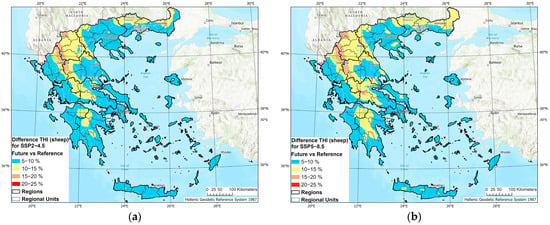
Figure 6.
The projected difference (future vs. reference period) in the mean THI (sheep) for each model grid cell under the SSP2-4.5 (a) and SSP5-8.5 (b) emission scenarios across Greece.
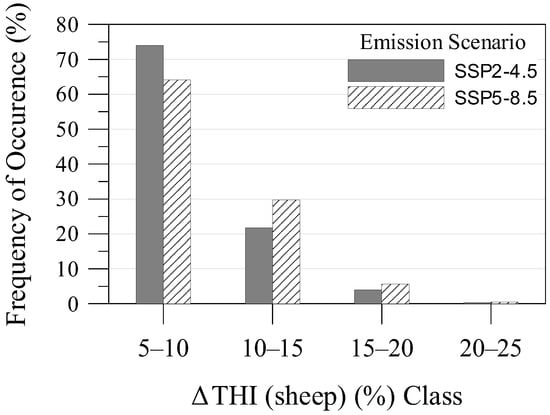
Figure 7.
Frequency of occurrence (%) of the number of model grid cells exhibiting each THI (sheep) difference [ΔΤHI (sheep)] (%) class presented in Figure 6.
The analysis was extended to examining the changes in the hourly THI (sheep) values that were projected to occur under each emission scenario. The results for each heat-stress category presented in Table 1 are highlighted in Table 3. Table 3 shows that the hourly THI (sheep) levels will be aggravated in the near future. The number of non-heat-stress hours will be reduced, and the number of severe heat-stress hours will double in almost the whole country. The number of extremely severe heat-stress hours will also double in most of the Greek territory. The deterioration in heat-stress conditions will be slightly more pronounced under the worst-case emission scenario.

Table 3.
Difference of the number of 1 h THI (sheep) values per model cell during the future period compared to the reference period for the two emission scenarios.
3.3. Assessment of Future Heat-Stress of Cattle
The application of the WRF model produced hourly values for each model cell for the meteorological parameters required in Equations (5) and (6), namely T, RH, WS, and SR, for the near future and the reference decade under the two examined emission scenarios. These values were used to calculate the hourly THI (cattle) and THI (adj) (cattle) using Equations (5) and (6), respectively. Additionally, the mean value for THI (adj) (cattle) was calculated for each model grid cell for the two periods for the two emission scenarios. The analysis that follows in this section is based on both the hourly and mean THI (adj) (cattle) values described above.
The mean ΔΤHI (adj) (cattle) projections are presented in Figure 8. For the intermediate emission scenario (SSP2-4.5), the mean THI (adj) (cattle) is projected to increase by 3–4% and less than 3% (Figure 8a) in 52% and 30% of Greek territory, respectively (Figure 9). The mean THI (adj) (cattle) shifted to higher values when the worst-case emission scenario (SSP5-8.5) was applied (Figure 8b and Figure 9). As for sheep, higher increases are projected for mountainous areas for both emission scenarios (Figure 8).
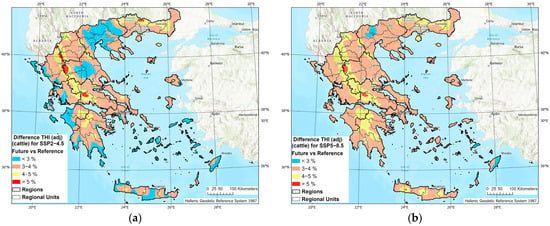
Figure 8.
The projected difference (future vs. reference period) in mean THI (adj) (cattle) for each model grid cell under the SSP2-4.5 (a) and SSP5-8.5 (b) emission scenarios across Greece.
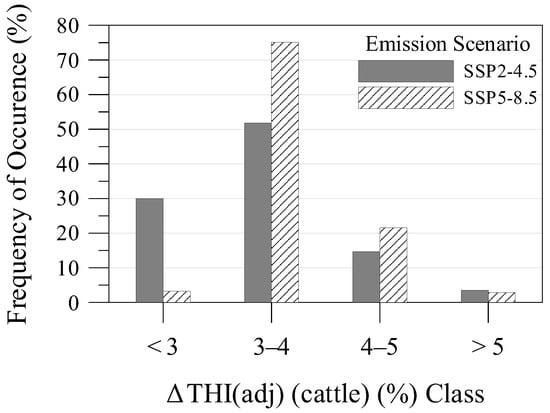
Figure 9.
Frequency of occurrence (%) of the number of model grid cells exhibiting each THI (adj) (cattle) difference [ΔΤHI (adj) (cattle)] (%) class presented in Figure 8.
The analysis was extended to examining the changes in the hourly THI (adj) (cattle) values that were projected to occur under each emission scenario. The results for each heat-stress category presented in Table 2 are highlighted in Table 4. Table 4 presents similar results to those reported in Table 3 for sheep, a fact that shows that cattle heat-stress levels will also be aggravated in the near future.

Table 4.
The difference in the number of 1 h THI (adj) (cattle) values per model cell during the future period compared to the reference period for the two emission scenarios.
3.4. Measures and Good Practices for Managing Potential Future Livestock Heat-Stress
This section outlines adaptation measures and good evidence-based practices to mitigate the anticipated rise in animal heat-stress that is expected to occur in the future due to climate change. These measures can be categorised into four domains, namely genetic selection and breeding, management of livestock housing conditions, nutritional interventions, and precision farming technological innovations. Specific suggestions for each category are presented below.
- Breeding heat-tolerant livestock species: (i) Breeding livestock species and breeds that demonstrate adaptive physiological traits and superior thermotolerance and (ii) the incorporation of heat-resistance traits such as sweat gland efficiency, coat colour, and metabolic rate regulation into genetic selection programs [].
- Microclimate management and environmental modifications: (i) Providing adequate natural (e.g., trees) or artificial (e.g., shelter) shade, natural or artificial ventilation, and cooling systems (e.g., sprinkler) and the use of insulating materials for the optimisation of air circulation and a reduction in heat build-up in barns; (ii) strategic grazing during early morning and late evening to avoid heat exposure; and (iii) seasonal modifications to animal stocking density and the avoidance of overcrowding to reduce heat build-up [].
- Nutritional management: (i) Free access to fresh, cool water and electrolytes to prevent dehydration and support thermoregulation; (ii) a reduction in fibre content and an increase in concentrates in the diet to reduce heat production from rumen fermentation; and (iii) the supplementation of antioxidants, such as vitamin E and selenium, to mitigate heat-induced oxidative stress [].
- Precision livestock farming technologies and evidence-based management practices: (i) Real-time monitoring systems of microenvironmental conditions and wearable sensors to track animal behaviour and heat-stress indicators like decreased mobility, increased body temperature, and respiration rate, dehydration, and reduced feed intake; (ii) automated phenotyping technologies; and (iii) proper veterinary care and nutritional and herd health management protocols to support immune system response and improve the health status of animals exposed to heat-stress conditions [].
Short-term heat-stress mitigation measures for livestock, including shade and mechanical ventilation structures, as well as more sufficient water access infrastructure, should be prioritised as being economically feasible and widely applicable. On the other hand, long-term solutions such as genetic selection for heat tolerance and the holistic integration of precision livestock farming technologies require strategic planning, policy support, and farmer education and investment. Farming systems in the regions which are projected to experience the most significant temperature increases, intense solar radiation, and hence prolonged exposure to heat-stress, particularly during summer months, will require urgent adaptation measures, i.e., improved shelter, water access, and cooling systems, to prevent productivity losses and health issues. The regions where temperature increases will be less dramatic will also face rising THI levels, but immediate interventions will be less urgent; however, long-term planning for genetic selection towards heat-tolerant phenotypes and infrastructure upgrades is still necessary.
4. Conclusions
This study integrated WRF modelling with the THI for livestock in Greece, enabling a granular analysis of heat-stress patterns across the country. The WRF model was used as a high-resolution regional climate model in this study and adequately simulated climate conditions in Greece. The model was applied to two emission scenarios, namely SSP2-4.5 (intermediate) and SSP5-8.5 (worst-case). The model’s projections were exploited to assess the changes in the heat-stress conditions of sheep and cattle that are projected to occur in the near future (2046–2055) compared to those in a reference period (2005–2014). Appropriate formulas for the THI were used to describe sheep and cattle heat-stress. The results showed that the mean THI levels are expected to rise by up to 10% in most of the country, indicating a deterioration in heat-stress conditions in the near future. This conclusion is also supported by the analysis of the hourly THI values that was conducted in the frame of this study. The increases will be more pronounced for sheep and slightly higher when considering the worst-case emission scenario. Sheep breeding mainly but also cattle breeding affect important sectors of the Greek agricultural economy, including, of course, agricultural income. Therefore, supporting these agricultural activities under climate change conditions with interventions into genetics, the environment, diet, and technology is a serious challenge for the future.
The integration of socio-economic modelling and testing adaptation strategies in field conditions considering the projected spatio-temporal distribution of farms and farming systems need to be considered further before proposing evidence-based, targeted mitigation measures. Additionally, employing multi-model ensembles could enhance the robustness of the projections by accounting for uncertainty related to both the model and internal variability. A dedicated analysis of extreme events, such as heat waves, would offer a valuable complementary perspective to the mean climate assessment presented in this study.
Author Contributions
Conceptualisation: D.K.P., A.I.G., D.M., A.P. (Anastasia Poupkou), and N.K.; methodology: D.K.P., A.I.G., G.P., D.M., and A.P. (Anastasia Poupkou); software: G.P., I.F., S.K., and I.S.; validation: G.P., D.M., S.K., and I.S.; formal analysis: D.K.P., A.I.G., G.P., and D.V.; investigation: D.K.P., A.I.G., G.P., K.D., A.P. (Athena Progiou), D.V., and A.P. (Anastasia Poupkou); resources: G.P., D.M., K.D., I.F., S.K., and A.P. (Anastasia Poupkou); data curation: G.P., K.D., I.F., S.K., I.S., and J.K.; writing—original draft preparation: D.K.P., A.I.G., G.P., A.P. (Anastasia Poupkou), and D.V.; writing—review and editing: D.K.P., A.I.G., G.P., D.M., A.P. (Anastasia Poupkou), and N.K.; visualisation: D.K.P., G.P., and I.F.; supervision: D.K.P., D.M., and A.P. (Anastasia Poupkou); project administration: D.K.P., D.M., and A.P. (Anastasia Poupkou); funding acquisition: D.K.P., D.M., A.P. (Anastasia Poupkou), and N.K. All authors have read and agreed to the published version of the manuscript.
Funding
This research was funded by the project “Crop and livestock stress under climate change scenarios (AGRO FUTURE CLIMATE STRESS)”, which was carried out within the framework of the National Recovery and Resilience Plan Greece 2.0, funded by the European Union—NextGenerationEU (Implementation body: HFRI).
Institutional Review Board Statement
Not applicable.
Data Availability Statement
The data presented in this study are available on request from the corresponding author.
Acknowledgments
The authors would like to acknowledge the support provided by the Digital Governance Unit of the Aristotle University of Thessaloniki (AUTh) throughout the progress of this research work.
Conflicts of Interest
The authors declare no conflicts of interest. The funders had no role in the design of the study; in the collection, analyses, or interpretation of data; in the writing of the manuscript; or in the decision to publish the results.
References
- Food and Agriculture Organization (FAO) of the United Nations, FAOSTAT 2023. Available online: https://www.fao.org/faostat/en/#home (accessed on 29 August 2025).
- Sejian, V.; Naqvi, S.M.K.; Ezeji, T.; Lakritz, J.; Lal, R. Environmental Stress and Amelioration in Livestock Production; Springer: Berlin/Heidelberg, Germany, 2012. [Google Scholar] [CrossRef]
- Aggarwal, A.; Upadhyay, R. Heat Stress and Animal Productivity; Springer: Chennai, India, 2013. [Google Scholar] [CrossRef]
- Sevi, A.; Annicchiarico, G.; Albenzio, M.; Taibi, L.; Muscio, A.; Dell’Aquila, S. Effects of solar radiation and feeding time on behavior, immune response and production of lactating ewes under high ambient temperature. J. Dairy Sci. 2001, 84, 629–640. [Google Scholar] [CrossRef]
- Finocchiaro, R.; van Kaam, J.B.C.H.M.; Portolano, B.; Misztal, I. Effect of heat stress on production of Mediterranean dairy sheep. J. Dairy Sci. 2005, 88, 1855–1864. [Google Scholar] [CrossRef]
- Sevi, A.; Caroprese, M. Impact of heat stress on milk production, immunity and udder health in sheep. Small Rumin. Res. 2012, 107, 1–7. [Google Scholar] [CrossRef]
- Panagakis, P.; Chronopoulou, E. Preliminary evaluation of the apparent short term HS of dairy ewes reared under hot summer conditions. Appl. Eng. Agric. 2010, 26, 1035–1042. [Google Scholar] [CrossRef]
- Papanastasiou, D.; Bartzanas, T.; Panagakis, P.; Kittas, C. Assessment of a typical sheep barn based on potential seasonal HS of dairy ewes. Appl. Eng. Agric. 2014, 30, 953–959. [Google Scholar] [CrossRef]
- Marino, R.; Atzori, A.S.; D’Andrea, M.; Iovane, G.; Trabalza-Marinucci, M.; Rinaldi, L. Climate change: Production performance, health issues, greenhouse gas emissions and mitigation strategies in sheep and goat farming. Small Rumin. Res. 2016, 135, 50–59. [Google Scholar] [CrossRef]
- Sejian, V.; Bhatta, R.; Gaughan, J.; Kumar Malik, P.; Naqvi, S.M.K.; Lal, R. Sheep Production Adapting to Climate Change; Springer Nature: Singapore, 2017. [Google Scholar] [CrossRef]
- Hellenic National Meteorological Service. Available online: https://www.emy.gr/en/the-climate-of-greece (accessed on 7 October 2025).
- Skamarock, W.C.; Klemp, J.; Dudhia, J.; Gill, D.O.; Barker, D.; Wang, W.; Powers, J.G. A Description of the Advanced Research WRF Version 3; NCAR/TN–475+STR; Mesoscale and Microscale Meteorology Division, National Center for Atmospheric Research: Boulder, CO, USA, 2008; pp. 3–27. [Google Scholar]
- Giorgi, F. Thirty years of regional climate modeling: Where are we and where are we going next? J. Geophys. Res. Atmos. 2019, 124, 5696–5723. [Google Scholar] [CrossRef]
- Giordano, C.; Vernin, J.; Vázquez Ramió, H.; Muñoz-Tuñón, C.; Varela, A.M.; Trinquet, H. Atmospheric and seeing forecast: WRF model validation with in situ measurements at ORM. Mon. Not. Royal Astronom. Soc. 2013, 430, 3102–3111. [Google Scholar] [CrossRef]
- Marta-Almeida, M.; Teixeira, J.C.; Carvalho, M.J.; Melo-Gonçalves, P.; Rocha, A.M. High resolution WRF climatic simulations for the Iberian Peninsula: Model validation. Phys. Chem. Earth 2016, 94, 94–105. [Google Scholar] [CrossRef]
- Giannaros, T.M.; Melas, D.; Ziomas, I. Performance evaluation of the Weather Research and Forecasting (WRF) model for assessing wind resource in Greece. Renew. Energy 2017, 102, 190–198. [Google Scholar] [CrossRef]
- Annor, T.; Lamptey, B.; Wagner, S.; Oguntunde, P.; Arnault, J.; Heinzeller, D.; Kunstmann, H. High-resolution long-term WRF climate simulations over Volta Basin. Part 1: Validation analysis for temperature and precipitation. Theor. Appl. Climatol. 2018, 133, 829–849. [Google Scholar] [CrossRef]
- Im, E.-S.; Ha, S.; Qiu, L.; Hur, J.; Jo, S.; Shim, K.-M. An evaluation of temperature-based agricultural indices over Korea from the high-resolution WRF simulation. Front. Earth Sci. 2021, 9, 656787. [Google Scholar] [CrossRef]
- Li, J.; Mahalov, A.; Hyde, P. Impacts of agricultural irrigation on ozone concentrations in the Central Valley of California and in the contiguous United States based on WRF-Chem simulations. Agric. For. Meteorol. 2016, 221, 34–49. [Google Scholar] [CrossRef]
- Hong, M.; Lee, S.-H.; Lee, S.-J.; Choi, J.-Y. Application of high-resolution meteorological data from NCAM-WRF to characterize agricultural drought in small scale farmlands based on soil moisture deficit. Agric. Water Manag. 2021, 243, 106494. [Google Scholar] [CrossRef]
- Riahi, K.; Van Vuuren, D.P.; Kriegler, E.; Edmonds, J.; O’Neill, B.C.; Fujimori, S.; Bauer, N.; Calvin, K.; Dellink, R.; Fricko, O.; et al. The Shared Socioeconomic Pathways and their energy, land use, and greenhouse gas emissions implications: An overview. Glob. Environ. Change 2017, 42, 153–168. [Google Scholar] [CrossRef]
- IPCC. Climate Change 2021: The Physical Science Basis. Contribution of Working Group I to the Sixth Assessment Report of the Intergovernmental Panel on Climate Change; Masson-Delmotte, V., Zhai, P., Pirani, A., Connors, S.L., Péan, C., Berger, S., Caud, N., Chen, Y., Goldfarb, L., Gomis, M.I., et al., Eds.; Cambridge University Press: Cambridge, UK; New York, NY, USA, 2021. [Google Scholar] [CrossRef]
- Hong, S.-Y.; Lim, J.-O.J. The WRF Single-Moment 6-Class Microphysics Scheme (WSM6). J. Atmos. Sci. 2006, 42, 129–151. [Google Scholar]
- Kain, J.S. The Kain–Fritsch Convective Parameterization: An Update. J. Appl. Meteor. Climatol. 2004, 43, 170–181. [Google Scholar] [CrossRef]
- Hong, S.; Noh, Y.; Dudhia, J. A New Vertical Diffusion Package with an Explicit Treatment of Entrainment Processes. Mon. Weather Rev. 2006, 134, 2318–2341. [Google Scholar] [CrossRef]
- Jiménez, P.A.; Dudhia, J.; González-Rouco, J.F.; Navarro, J.; Montávez, J.P.; García-Bustamante, E. A Revised Scheme for the WRF Surface Layer Formulation. Mon. Weather Rev. 2012, 140, 898–918. [Google Scholar] [CrossRef]
- Tewari, M.; Chen, F.; Wang, W.; Dudhia, J.; LeMone, M.A.; Mitchell, K.; Ek, M.; Gayno, G.; Wegiel, J.; Cuenca, R.H. Implementation and verification of the unified NOAH land surface model in the WRF model. In Proceedings of the 20th Conference on Weather Analysis and Forecasting/16th Conference on Numerical Weather Prediction, Seattle, WA, USA, 11–15 January 2004. [Google Scholar]
- Iacono, M.J.; Delamere, J.S.; Mlawer, E.J.; Shephard, M.W.; Clough, S.A.; Collins, W.D. Radiative forcing by long-lived greenhouse gases: Calculations with the AER radiative transfer models. J. Geophys. Res. Atmos. 2008, 113, 2–9. [Google Scholar] [CrossRef]
- Giannaros, C.; Melas, D.; Giannaros, T.M. On the short-term simulation of heat waves in the Southeast Mediterranean: Sensitivity of the WRF model to various physics schemes. Atmos. Res. 2019, 218, 99–116. [Google Scholar] [CrossRef]
- Politi, N.; Nastos, P.T.; Sfetsos, A.; Vlachogiannis, D.; Dalezios, N.R. Evaluation of the AWR-WRF model configuration at high resolution over the domain of Greece. Atmos. Res. 2018, 208, 229–245. [Google Scholar] [CrossRef]
- Tateishi, R.; Thanh Hoan, N.; Kobayashi, T.; Alsaaideh, B.; Tana, G.; Xuan Phong, D. Production of Global Land Cover Data-GLCNMO2008. J. Geogr. Geol. 2014, 6, 99–122. [Google Scholar] [CrossRef]
- Xu, Z.; Han, Y.; Tam, C.-Y.; Yang, Z.-L.; Fu, C. Bias-corrected CMIP6 global dataset for dynamical downscaling of the historical and future climate (1979–2100). Sci. Data 2021, 8, 293. [Google Scholar] [CrossRef]
- Xu, Z.F.; Han, Y.; Zhang, M.-Z.; Tam, C.Y.; Yang, Z.-L.; El Kenawy, A.; Fu, C.B. Assessing the performance of a dynamical downscaling simulation driven by a bias-corrected CMIP6 dataset for Asian climate. Adv. Atmos. Sci. 2024, 41, 974–988. [Google Scholar] [CrossRef]
- Muñoz-Sabater, J.; Dutra, E.; Agustí-Panareda, A.; Albergel, C.; Arduini, G.; Balsamo, G.; Boussetta, S.; Choulga, M.; Harrigan, S.; Hersbach, H.; et al. ERA5-Land: A state-of-the-art global reanalysis dataset for land applications. Earth Syst. Sci. Data 2021, 13, 4349–4383. [Google Scholar] [CrossRef]
- McManus, C.; Bianchini, E.; Paim, T.D.P.; De Lima, F.G.; Neto, J.B.; Castanheira, M.; Esteves, G.I.F.; Cardoso, C.C.; Dalcin, V.C. Infrared Thermography to Evaluate Heat Tolerance in Different Genetic Groups of Lambs. Sensors 2015, 15, 17258–17273. [Google Scholar] [CrossRef]
- Panagakis, P. Potential seasonal HS of sheep: Assessment of four husbandry areas in Greece. Appl. Eng. Agric. 2016, 32, 125–129. [Google Scholar] [CrossRef]
- Marai, I.F.M.; El-Darawany, A.A.; Fadiel, A.; Abdel-Hafez, M.A.M. Physiological traits as affected by heat stress in sheep-A review. Small Rumin. Res. 2007, 71, 1–12. [Google Scholar] [CrossRef]
- Mader, T.L.; Davis, M.S.; Brown-Brandl, T. Environmental factors influencing heat stress in feedlot cattle. J. Anim. Sci. 2006, 84, 712–719. [Google Scholar] [CrossRef]
- Skliris, N.; Marsh, R.; Breedon, M.; Josey, S.A. Accelerated Warming and Salinification of the Mediterranean Sea: Implications for Dense Water Formation. J. Mar. Sci. Eng. 2025, 13, 25. [Google Scholar] [CrossRef]
- Gimeno-Sotelo, L.; Fernández-Alvarez, J.C.; Nieto, R.; Vicente-Serrano, S.M.; Gimeno, L. The increasing influence of atmospheric moisture transport on hydrometeorological extremes in the Euromediterranean region with global warming. Commun. Earth Environ. 2024, 5, 604. [Google Scholar] [CrossRef]
- Carabaño, M.J.; Ramón, M.; Menéndez-Buxadera, A.; Molina, A.; Díaz, C. Selecting for heat tolerance. Anim. Front. 2019, 9, 62–68. [Google Scholar] [CrossRef]
- Havelka, Z.; Kunes, R.; Kononets, Y.; Stokes, J.E.; Smutny, L.; Olsan, P.; Kresan, J.; Stehlik, R.; Bartos, P.; Xiao, M.; et al. Technology of Microclimate Regulation in Organic and Energy-Sustainable Livestock Production. Agriculture 2022, 12, 1563. [Google Scholar] [CrossRef]
- Kausar, R.; Imran, S. Heat Stress Mitigation through Feeding and Nutritional Interventions in Ruminants. In Latest Scientific Findings in Ruminant Nutrition—Research for Practical Implementation; Babinszky, L., Ed.; IntechOpen: London, UK, 2024. [Google Scholar] [CrossRef]
- Koltes, J.E.; Koltes, D.A.; Mote, B.E.; Tucker, J.; Hubbell, D.S. Automated collection of heat stress data in livestock: New technologies and opportunities. Transl. Anim. Sci. 2018, 2, 319–323. [Google Scholar] [CrossRef] [PubMed]
Disclaimer/Publisher’s Note: The statements, opinions and data contained in all publications are solely those of the individual author(s) and contributor(s) and not of MDPI and/or the editor(s). MDPI and/or the editor(s) disclaim responsibility for any injury to people or property resulting from any ideas, methods, instructions or products referred to in the content. |
© 2025 by the authors. Licensee MDPI, Basel, Switzerland. This article is an open access article distributed under the terms and conditions of the Creative Commons Attribution (CC BY) license (https://creativecommons.org/licenses/by/4.0/).